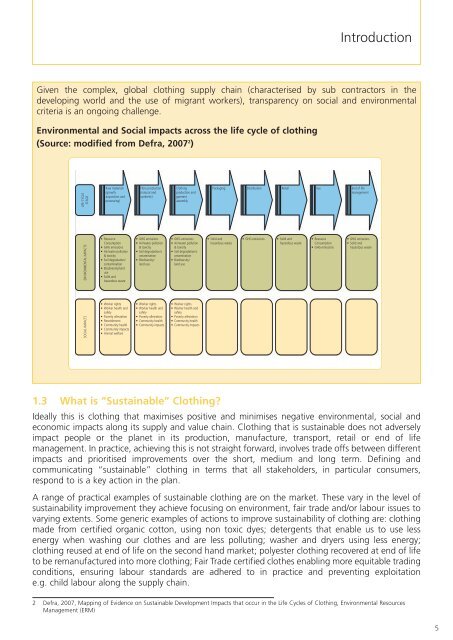SUSTAINABLE CLOTHING ACTION PLAN - Defra
SUSTAINABLE CLOTHING ACTION PLAN - Defra
SUSTAINABLE CLOTHING ACTION PLAN - Defra
You also want an ePaper? Increase the reach of your titles
YUMPU automatically turns print PDFs into web optimized ePapers that Google loves.
1.3 What is “Sustainable” Clothing?<br />
Introduction<br />
Given the complex, global clothing supply chain (characterised by sub contractors in the<br />
developing world and the use of migrant workers), transparency on social and environmental<br />
criteria is an ongoing challenge.<br />
Environmental and Social impacts across the life cycle of clothing<br />
(Source: modified from <strong>Defra</strong>, 2007 2 )<br />
LIFE CYCLE<br />
STAGE<br />
ENVIRONMENTAL IMPACTS<br />
SOCIAL IMPACTS<br />
Raw materials<br />
(growth,<br />
acquisition and<br />
processing)<br />
• Resource<br />
Consumption<br />
• GHG emissions<br />
• Air/water pollution<br />
& toxicity<br />
• Soil degradation/<br />
contamination<br />
• Biodiversity/land<br />
use<br />
• Solid and<br />
hazardous waste<br />
• Worker rights<br />
• Worker health and<br />
safety<br />
• Poverty alleviation<br />
• Resettlement<br />
• Community health<br />
• Community impacts<br />
• Animal welfare<br />
Fibre production<br />
(natural and<br />
synthetic)<br />
• GHG emissions<br />
• Air/water pollution<br />
& toxicity<br />
• Soil degradation/c<br />
ontamination<br />
• Biodiversity/<br />
land use<br />
• Worker rights<br />
• Worker health and<br />
safety<br />
• Poverty alleviation<br />
• Community health<br />
• Community impacts<br />
Clothing<br />
production and<br />
garment<br />
assembly<br />
• GHG emissions<br />
• Air/water pollution<br />
& toxicity<br />
• Soil degradation/c<br />
ontamination<br />
• Biodiversity/<br />
land use<br />
• Worker rights<br />
• Worker health and<br />
safety<br />
• Poverty alleviation<br />
• Community health<br />
• Community impacts<br />
Packaging Distribution Retail Use End of life<br />
management<br />
• Solid and<br />
hazardous waste<br />
• GHG emissions<br />
• Solid and<br />
hazardous waste<br />
• Resource<br />
Consumption<br />
• GHG emissions<br />
• GHG emissions<br />
• Solid and<br />
hazardous waste<br />
Ideally this is clothing that maximises positive and minimises negative environmental, social and<br />
economic impacts along its supply and value chain. Clothing that is sustainable does not adversely<br />
impact people or the planet in its production, manufacture, transport, retail or end of life<br />
management. In practice, achieving this is not straight forward, involves trade offs between different<br />
impacts and prioritised improvements over the short, medium and long term. Defining and<br />
communicating “sustainable” clothing in terms that all stakeholders, in particular consumers,<br />
respond to is a key action in the plan.<br />
A range of practical examples of sustainable clothing are on the market. These vary in the level of<br />
sustainability improvement they achieve focusing on environment, fair trade and/or labour issues to<br />
varying extents. Some generic examples of actions to improve sustainability of clothing are: clothing<br />
made from certified organic cotton, using non toxic dyes; detergents that enable us to use less<br />
energy when washing our clothes and are less polluting; washer and dryers using less energy;<br />
clothing reused at end of life on the second hand market; polyester clothing recovered at end of life<br />
to be remanufactured into more clothing; Fair Trade certified clothes enabling more equitable trading<br />
conditions, ensuring labour standards are adhered to in practice and preventing exploitation<br />
e.g. child labour along the supply chain.<br />
2 <strong>Defra</strong>, 2007, Mapping of Evidence on Sustainable Development Impacts that occur in the Life Cycles of Clothing, Environmental Resources<br />
Management (ERM)<br />
5

















